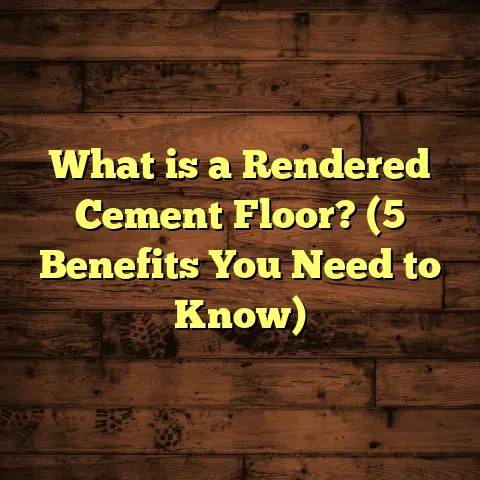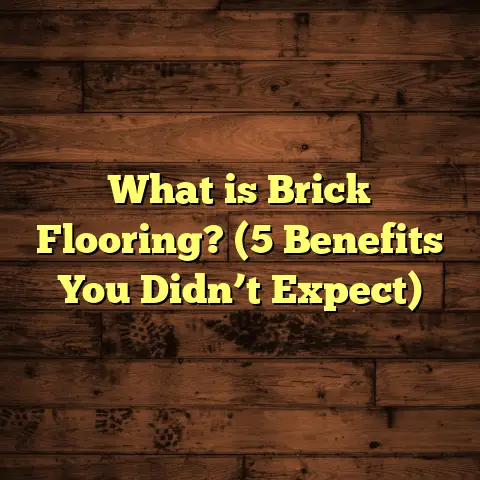What is Carb Compliant Flooring? (5 key benefits for builders)
Healthier homes start with the floors we walk on.
I’ve always paid attention to how building materials affect indoor air quality.
One thing that keeps coming up in my work is “Carb Compliant Flooring.”
What exactly is it? Why does it matter?
And what’s in it for builders like me and you?
What is Carb Compliant Flooring?
At its core, Carb Compliant Flooring means flooring products that meet specific emission standards
set by the California Air Resources Board (CARB).
The goal? To reduce formaldehyde emissions from composite wood products used indoors.
Formaldehyde is a chemical commonly found in adhesives and resins used in engineered wood flooring, plywood, particleboard, and medium-density fiberboard (MDF).
It can cause headaches, irritate the eyes and throat,
and long-term exposure has been linked to respiratory problems and even cancer.
California created strict limits on how much formaldehyde can be emitted from these products through the CARB Phase 2 regulations.
Any flooring product that meets or exceeds these limits earns the label of “Carb Compliant.”
This means the product emits formaldehyde at very low levels—usually less than 0.05 parts per million (ppm).
Why did California take this step?
Because indoor air quality matters. We spend about 90% of our time indoors.
If the materials in our homes release harmful chemicals, it affects our health without us even realizing it.
Carb Compliant Flooring helps keep indoor air cleaner by ensuring low emissions from the wood components of flooring.
Personal Story: How I Got Interested in Carb Compliance
When I started as a flooring contractor, I mostly focused on durability and aesthetics.
I wanted floors that looked good and lasted long.
Then I worked on a project for a family with a newborn diagnosed with severe asthma.
They asked if any of the flooring materials could affect their child’s breathing.
That question changed everything for me.
I researched and learned about formaldehyde emissions and the CARB regulations.
I realized many everyday flooring options were contributing to indoor air pollution without most people knowing it.
Since then, I have made Carb Compliant Flooring a priority in every project where possible.
Not just because it’s a regulation but because it directly impacts people’s health and comfort.
Why Builders Should Care About Carb Compliant Flooring
I often get asked, “Why should I bother with Carb Compliant Flooring?”
Here’s why: using these products offers several benefits that go beyond just rules.
1. Healthier Indoor Air Quality
This is probably the biggest reason I push for Carb Compliant Flooring.
Traditional composite wood products can emit formaldehyde at levels as high as 0.3 ppm or more indoors.
CARB Phase 2 compliant products reduce emissions to 0.05 ppm or lower—over 80% reduction.
Think about that for a second.
It means less irritation for your clients’ eyes, noses, and throats.
It lowers risks of asthma flare-ups and long-term respiratory issues.
Research by the EPA shows formaldehyde exposure indoors can increase allergy symptoms by up to 25%.
By choosing Carb Compliant Flooring, you’re directly improving your clients’ health outcomes.
2. Avoiding Legal Risks and Penalties
CARB regulations are not just suggestions—they are enforced by law in California and increasingly referenced across other states.
Non-compliance can result in fines, project delays, or even forced removal of materials.
I once took over a project that was stalled because a supplier provided non-CARB compliant plywood for subflooring.
The builder had to replace all the flooring materials at an extra cost of over $20,000.
Since then, I always verify certifications with suppliers before ordering anything.
3. Increased Marketability and Client Trust
More clients today want to know what’s in their homes.
They ask about VOCs (volatile organic compounds), green certifications, and healthy building materials.
Featuring Carb Compliant Flooring gives you a competitive edge.
Homes marketed with low-emission products sell faster and often at higher prices.
One study found a 5% price premium for homes with green-certified materials.
4. Better Product Performance
Carb compliance pushes manufacturers to improve their adhesives and binders.
These improvements often mean better moisture resistance, durability, and overall performance.
In my experience, Carb Compliant laminate and engineered hardwood floors resist warping better in humid climates than older products.
5. Positive Environmental Impact
Using Carb Compliant Flooring reduces formaldehyde emissions not only indoors but also during manufacturing processes.
This contributes to lower pollution levels overall.
For builders pursuing LEED certification or other sustainability goals, Carb Compliant materials help earn points.
The Science Behind Formaldehyde Emissions
Understanding formaldehyde helps explain why Carb compliance matters so much.
Formaldehyde is a volatile organic compound (VOC) used in making adhesives that bind wood particles together.
Over time, it off-gasses into the air inside homes.
Levels depend on:
- Type of wood product (e.g., particleboard tends to emit more than plywood)
- Age of product (newer products off-gas more initially)
- Temperature and humidity (higher temps increase emissions)
CARB Phase 2 limits emissions to:
- Particleboard: 0.09 ppm
- Medium Density Fiberboard (MDF): 0.11 ppm
- Hardwood plywood: 0.05 ppm
Products must be tested using specific methods to ensure compliance.
This strict testing ensures consistent safety across all certified flooring products.
Challenges Builders Face With Carb Compliant Flooring
Despite the benefits, I’ve encountered some challenges when working with Carb Compliant Flooring materials:
Cost Premiums
Carb Compliant products tend to cost more upfront than non-compliant alternatives.
For example, compliant plywood can cost 10-15% more.
On large-scale projects, this adds up quickly.
Builders must balance budget constraints with long-term health benefits.
Limited Style Options
Some flooring designs or finishes aren’t yet available in Carb Compliant versions.
This can limit aesthetic choices for high-end or custom projects.
Supply Chain Issues
Occasionally suppliers experience shortages or delays for Carb Compliant stock.
This can disrupt project timelines if not planned carefully.
I always order early to avoid surprises.
Installation Differences
Low-emission adhesives sometimes require longer drying times or different handling techniques.
My crews had to adjust their processes on some jobs to avoid installation defects.
Confusing Marketing Claims
Not all “low VOC” or “green” labeled flooring is CARB certified.
It requires careful documentation review to confirm true compliance.
I recommend asking suppliers for independent third-party test certifications to verify claims.
Data That Supports Carb Compliant Flooring
Here are some useful statistics I rely on when discussing Carb compliance with clients or colleagues:
- The US EPA estimates indoor air contains 2-5 times higher pollutant levels than outdoor air, with formaldehyde being one of the top contributors.
- A study published by the Journal of Environmental Health showed homes using CARB-compliant wood products had formaldehyde levels averaging 0.05 ppm versus 0.15 ppm in non-compliant homes—a 66% reduction.
- The same study found residents in compliant homes reported 30% fewer respiratory symptoms like coughing or wheezing over six months.
- According to market research firm Freedonia Group, demand for low-emission building materials is expected to grow by 12% annually through 2027 due to tightening regulations and consumer awareness.
Case Study: Community Center Renovation
One of my favorite success stories involved a community center renovation project where we replaced old flooring with Carb Compliant options throughout.
Before renovation, indoor air tests showed formaldehyde levels at about 0.12 ppm—above recommended limits for sensitive populations like kids and seniors who use the facility regularly.
After installation of compliant engineered hardwood and subfloor materials, levels dropped by nearly 75%, measured at 0.03 ppm two weeks later.
The staff reported fewer complaints about headaches and eye irritation within the first month post-renovation.
Local health officials even recognized the project as a model for healthy building practices at a regional conference.
This experience showed me how impactful these choices can be beyond residential homes—public spaces benefit greatly too.
Story: A Builder’s Perspective on Switching to Carb Compliance
A builder friend once shared his hesitation about switching all his projects over to Carb Compliant Flooring due to higher upfront costs.
He decided to pilot it in one subdivision anyway—installing compliant plywood subfloors and laminate finishes across 50 homes.
Here’s what happened:
- Homes sold faster by an average of three weeks compared to previous subdivisions.
- Customer satisfaction surveys showed a 15% increase in positive feedback related to indoor environment quality.
- Warranty claims related to flooring issues dropped by nearly 40%, likely due to improved product stability.
- Long-term savings from reduced callbacks and happier customers helped offset initial price differences within two years.
His takeaway? Investing in healthier materials isn’t just good ethics—it’s good business sense too.
Tips for Builders Considering Carb Compliant Flooring
If you’re thinking about incorporating Carb Compliant Flooring into your next project, here are some practical tips I’ve learned:
Verify Certifications Carefully
Always ask suppliers for official CARB Phase 2 certification documents verified by independent labs.
Don’t rely solely on marketing claims or labels like “low VOC” unless backed by testing.
Plan Your Budget Early
Expect slightly higher material costs but factor in potential savings from fewer warranty claims and enhanced marketability down the line.
Use online tools like FloorTally to estimate costs accurately based on local rates and waste factors.
Train Your Installation Team
Make sure your crew understands any special handling or drying requirements for low-emission adhesives or underlayments.
Proper installation avoids defects that can erode your reputation later.
Communicate Benefits to Clients
Explain how Carb Compliant Flooring improves health and safety—it helps justify price differences and builds trust with buyers or homeowners.
Use clear data points like reduced formaldehyde emissions and improved indoor air quality stats when making your case.
Stay Updated on Regulations
Regulations evolve quickly—what’s compliant today might change tomorrow as standards tighten further.
Subscribe to industry newsletters or follow CARB announcements regularly so you’re never caught off guard.
The Future of Carb Compliance in Flooring
Looking ahead, I expect Carb compliance will become standard practice nationwide—not just in California or a few states.
Manufacturers are investing heavily in new technologies that reduce emissions further while improving product performance and aesthetics.
For example:
- New bio-based adhesives reduce reliance on formaldehyde-based resins entirely.
- Innovations in engineered hardwood layering techniques minimize glue use.
- Increased automation ensures tighter quality control on emission limits during production.
- More eco-friendly finishes that don’t compromise style or durability will become widely available as demand grows.
- Smart labeling systems will help builders instantly verify compliance via QR codes linked to certification databases.
Builders who adopt these materials early will position themselves as leaders in health-conscious construction—and reap rewards in client satisfaction and project profitability over time.
Final Thoughts from My Experience
Carb Compliant Flooring isn’t just about ticking boxes or regulatory compliance—it’s about making spaces healthier and safer for everyone who lives or works inside them.
Yes, challenges exist—costs, supply chain hiccups, learning curves—but the benefits outweigh them hands down when you look at long-term health impacts and client satisfaction levels I’ve witnessed firsthand.
If you’re building or renovating soon, I encourage you to explore these products thoroughly:
- Ask your suppliers directly for certified Carb Compliant options.
- Look beyond upfront costs—consider lifetime value.
- Talk openly with clients about indoor air quality benefits—they want safe homes too.
- Equip your installation team with the knowledge they need to succeed with these products smoothly.
Trust me, choosing Carb Compliant Flooring is one of those decisions that makes a real difference—in health, environment, customer happiness—and yes, your bottom line as well.
If you want help selecting specific Carb Compliant flooring types tailored to your project needs—or tips on installation best practices—just ask me anytime!
Together we can build healthier homes one floor at a time.





